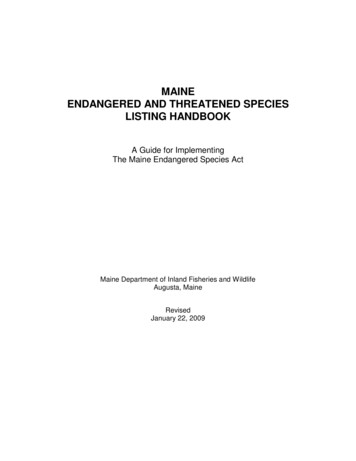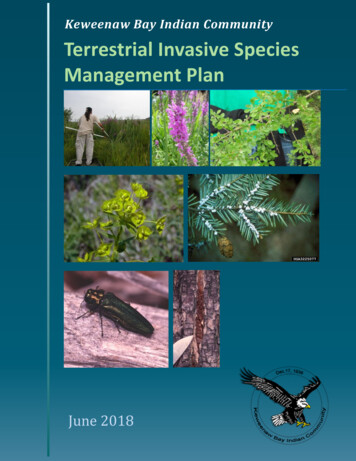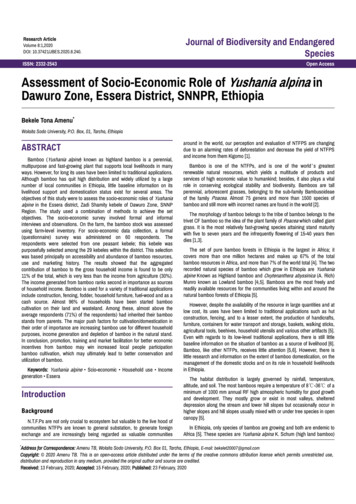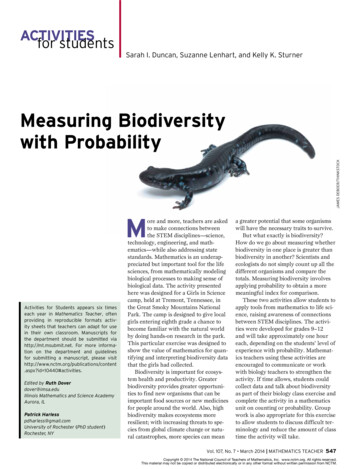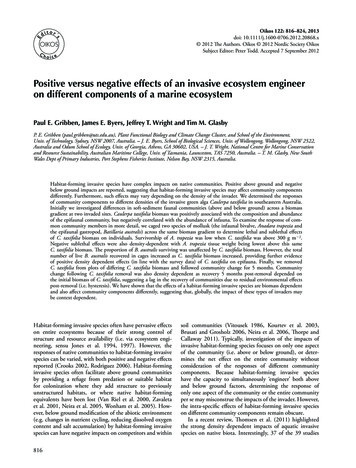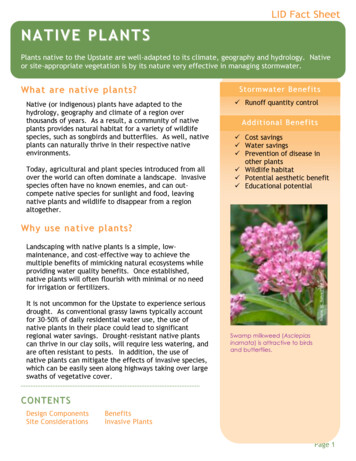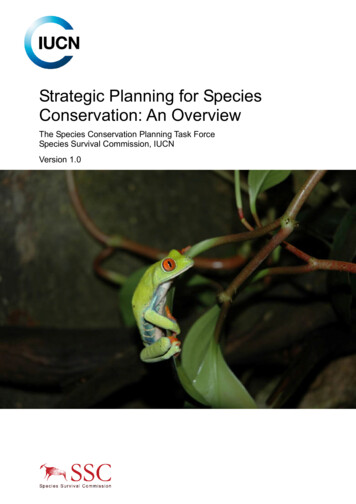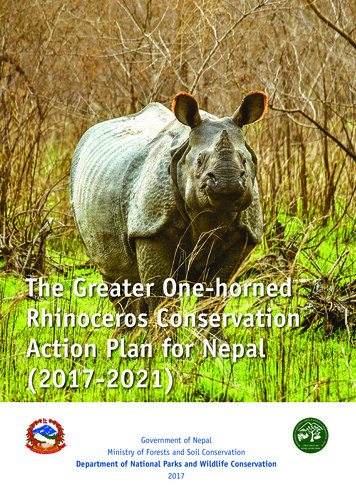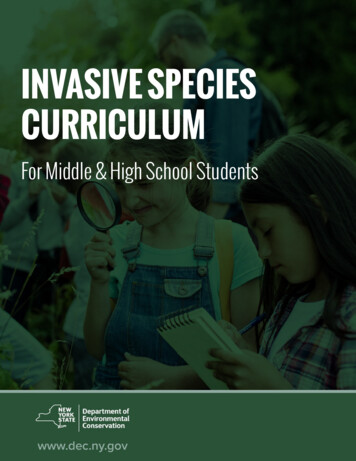
Transcription
INVASIVE SPECIES CURRICULUM FOR MIDDLE & HIGH SCHOOL STUDENTSINVASIVE SPECIESCURRICULUMFor Middle & High School Studentswww.dec.ny.govNEW YORK STATE DEPARTMENT OF ENVIRONMENTAL CONSERVATION1
INVASIVE SPECIES CURRICULUM FOR MIDDLE & HIGH SCHOOL STUDENTSTABLE OF CONTENTSAcknowledgments . . . . . . . . . . . . . . . . . . . . . . . . . . . . . . . . . . . . . . . . . . . . . . . . . . 3Background . . . . . . . . . . . . . . . . . . . . . . . . . . . . . . . . . . . . . . . . . . . . . . . . . . . . . . . . 4Standards . . . . . . . . . . . . . . . . . . . . . . . . . . . . . . . . . . . . . . . . . . . . . . . . . . . . . . . . . . 5CurriculumDay 1: Introduction to invasive species . . . . . . . . . . . . . . . . . . . . . . . . . . . . . . . . . . . . . . . . . . . . . 6Day 2: Risk of spread . . . . . . . . . . . . . . . . . . . . . . . . . . . . . . . . . . . . . . . . . . . . . . . . . . . . . . . . . . . 8Day 3: Plant identification. . . . . . . . . . . . . . . . . . . . . . . . . . . . . . . . . . . . . . . . . . . . . . . . . . . . . . . 9Day 4: iMapInvasives introduction . . . . . . . . . . . . . . . . . . . . . . . . . . . . . . . . . . . . . . . . . . . . . . . . . 10Day 5: Campus field work . . . . . . . . . . . . . . . . . . . . . . . . . . . . . . . . . . . . . . . . . . . . . . . . . . . . . . . . 11Day 6: Analysis of class data . . . . . . . . . . . . . . . . . . . . . . . . . . . . . . . . . . . . . . . . . . . . . . . . . . . . . . 12Day 7: Field trip (optional) . . . . . . . . . . . . . . . . . . . . . . . . . . . . . . . . . . . . . . . . . . . . . . . . . . . . . . . . 13Day 8: Big picture . . . . . . . . . . . . . . . . . . . . . . . . . . . . . . . . . . . . . . . . . . . . . . . . . . . . . . . . . . . . . . . 14Day 9: Poster session . . . . . . . . . . . . . . . . . . . . . . . . . . . . . . . . . . . . . . . . . . . . . . . . . . . . . . . . . . . . 15Day 10: Action/service-learning day (optional) . . . . . . . . . . . . . . . . . . . . . . . . . . . . . . . . . . . . . . . . 16WorksheetsPre-assessment Form . . . . . . . . . . . . . . . . . . . . . . . . . . . . . . . . . . . . . . . . . . . . . . . . . . . . . . . . . . . . 19Invasive Species Research Notes . . . . . . . . . . . . . . . . . . . . . . . . . . . . . . . . . . . . . . . . . . . . . . . . 20Invasive Species Observations . . . . . . . . . . . . . . . . . . . . . . . . . . . . . . . . . . . . . . . . . . . . . . . . . . 22Field Research Form . . . . . . . . . . . . . . . . . . . . . . . . . . . . . . . . . . . . . . . . . . . . . . . . . . . . . . . . . . .24Procedure Note Sheet . . . . . . . . . . . . . . . . . . . . . . . . . . . . . . . . . . . . . . . . . . . . . . . . . . . . . . . . . 28Poster Session Question Prompt Sheet . . . . . . . . . . . . . . . . . . . . . . . . . . . . . . . . . . . . . . . . . . . 29Post-assessment Form . . . . . . . . . . . . . . . . . . . . . . . . . . . . . . . . . . . . . . . . . . . . . . . . . . . . . . . . . 30Additional Resources10 Common Terrestrial Invasive Species of New York . . . . . . . . . . . . . . . . . . . . . . . . . . . . . . . .32Partnerships for Regional Invasive Species Management (PRISMs) . . . . . . . . . . . . . . . . . . . . . .342NEW YORK STATE DEPARTMENT OF ENVIRONMENTAL CONSERVATION
INVASIVE SPECIES CURRICULUM FOR MIDDLE & HIGH SCHOOL STUDENTSACKNOWLEDGMENTSThe New York State Department of Environmental Conservation would like to thank the following people forassisting in the planning, writing, and implementation of the invasive species curriculum:EMILY CABOOTANN CROTTYState University of New York at Albany and New YorkState Department of Environmental Conservation internNew York State Education DepartmentEMMA ANTOLOSPace UniversityNew York State Department ofEnvironmental ConservationDONNA CASSIDY-HANLEYJENNIFER DEANNew York Natural Heritage Program, iMapInvasivesLAURA LEHTONENMATTHEW AIELLOCornell UniversityMIKE JABOTState University of New York, College at FredoniaCapital District BOCESMEGAN PHILLIPSAMANDA ZULLONew York State Department ofEnvironmental ConservationNew York State Education DepartmentThis project was made possible through funding from the Environmental Protection Fund, which is administered by theNew York State Department of Environmental Conservation .NEW YORK STATE DEPARTMENT OF ENVIRONMENTAL CONSERVATION3
INVASIVE SPECIES CURRICULUM FOR MIDDLE & HIGH SCHOOL STUDENTSBACKGROUNDThe purpose of this unit is to bring students through the scientific process to develop their own scientific research posterfocusing on the statewide issue of invasive species . The process will occur over about two weeks and includes a visiting speaker,fieldwork, optional field trip, and a summary scientific poster session . The groups will be led through prompts to research invasivespecies topics, including: What are invasive species? How do they impact students’ lives? How do they travel? Do the school campus and local areas have invasivespecies? What can be done to manage and prevent invasivespecies from coming to the area?DAY 1DAY 2DAY 3DAY 4DAY 5What are invasivespecies?How do invasivespecies spread?What do invasivespecies look like?Introduction writingIntroduction writingOptional speakerand hands-on plantidentificationMethods writing andfield day preparationCampus fieldworkDAY 6DAY 7DAY 8DAY 9DAY 10Are there anypatterns in the class’sdata?What are landmanagers doingabout invasivespecies?What is being done inNew York State aboutinvasive species?What did studentslearn?Service-learning dayData analysis, resultswriting, andmethods editingOptional field tripConclusion writingPoster sessionOptional invasivespecies communityservice dayWhat invasive species What invasive speciesare an issue locally?are on the schoolgrounds?Aims and objectivesStudents will be able to: Create a group research poster summarizing theirinvasive species study; Analyze their field data to be used in their invasivespecies study; and Summarize what invasive species are and how theyimpact humans .4NEW YORK STATE DEPARTMENT OF ENVIRONMENTAL CONSERVATION
INVASIVE SPECIES CURRICULUM FOR MIDDLE & HIGH SCHOOL STUDENTSSTANDARDSMIDDLE SCHOOL STANDARDSHIGH SCHOOL STANDARDSMS-LS2-4.HS-LS2-2.Construct an argument supported by empirical evidencethat changes to physical or biological components of anecosystem affect populations . [Clarification Statement:Emphasis is on recognizing patterns in data and makingwarranted inferences about shifts in populations due tochanges in the ecosystem.]Use mathematical representations to support andrevise explanations based on evidence about factorsaffecting biodiversity and populations in ecosystemsof different scales . [Clarification Statement: Examplesof mathematical representations could include findingthe average, determining trends, and using graphicalcomparisons of multiple sets of data.] [AssessmentBoundary: Assessment is limited to provided data.]MS-LS2-5.Evaluate competing design solutions for maintainingbiodiversity and protecting ecosystem stability .[Clarification Statement: Examples of ecosystemprotections could include water purification, wastemanagement, nutrient recycling, prevention of soilerosion, and eradication of invasive species. Examplesof design solution constraints could include scientific,economic, and social considerations.]MS-ESS3-3.Apply scientific principles to design a method formonitoring and minimizing a human impact on theenvironment . [Clarification Statement: Examples ofthe design process could include examining humanenvironmental impacts, assessing the kinds of solutionsthat are feasible, and designing and evaluatingsolutions that could reduce that impact. Examples ofhuman impacts could include water usage (such asthe withdrawal of water from streams and aquifers orthe construction of dams and levees), land usage (suchas urban development, agriculture, or the removal ofwetlands), and pollution (such as of the air, water, or land).]HS-LS2-7.Design, evaluate, and refine a solution for reducing theimpacts of human activities on the environment andbiodiversity . [Clarification Statement: Examples of humanactivities could include urbanization, building dams, anddissemination of invasive species. Examples of solutionscould include simulations, product development,technological innovations, and/or legislation.]HS-LS4-5.Evaluate the evidence supporting claims that changes inenvironmental conditions may result in: (1) increases in thenumber of individuals of some species, (2) the emergenceof new species over time, and (3) the extinction ofother species . [Clarification Statement: Emphasis ison determining cause and effect relationships for howchanges to the environment such as deforestation,fishing, introduction of invasive species, application offertilizers, drought, flood, and the rate of change of theenvironment affect distribution or disappearance of traitsin species.]NEW YORK STATE DEPARTMENT OF ENVIRONMENTAL CONSERVATION5
INVASIVE SPECIES CURRICULUM FOR MIDDLE & HIGH SCHOOL STUDENTSDAY 1: INTRODUCTION TO INVASIVE SPECIES40-MINUTE LESSONObjectivesDriving questions What are invasive species?Students will be able to: Summarize what invasive species are and howthey impact society . How do invasive species impact our lives?Materials Chromebooks/laptops/desktop computers Pre-assessment survey (see page 19) Research note sheet (see pages 20-21) Student working poster Colored pencils/markers/construction paper(if handwriting intro)Teacher will show groups the example of the posterin PowerPoint (see example on page 7) . Teacher willhand out permission slips for students to download theiMapInvasives app on smartphones or tablets(10 minutes) .Note: you can create an iMapInvasives account for yourclassroom. Students do not need to make their ownaccounts. If downloading the app is not preferable orposes an issue, students can use the worksheets onpages 24–27 and enter the data manually onto theiMapInvasives website.Entry EventTo begin the unit, the students will brainstorm whatthey already know about invasive species using theassessment worksheet (see page 19) for Day 1 . Studentswill first brainstorm independently what they know aboutinvasive species . After a few minutes, each student willpair with a neighbor and add new facts and topics tothe partner section of the worksheet . Then the teacherwill open the discussion to the group and have studentsshare their ideas . The teacher will record students’ ideason a sheet of paper, whiteboard, smartboard, etc . Theideas list should be left up for the duration of the classperiod to act as a starting point in the groups’ research .This activity will introduce students to concepts they willlearn over the course of the unit (5 minutes) .The student groups will begin their research, focusingon two questions: (1) What are invasive species? and(2) How do they impact our lives? These questions shouldbe visible to the students while they are researching andcan be found on a slide within the unit PowerPoint .ActivityTeacher will begin the unit PowerPoint, available urces.The first slides contain a video that explains what invasivespecies are, how they are transported, and how theyimpact communities . These are the major topics thatstudents will be researching for the introduction of theirposter (5 minutes) .Students may use online sources, pamphlets, fliers, ortexts from the school library . Students should take noteson these two focusing questions, including their citationsin the student note sheet (see pages 20–21) (10 minutes) .Teacher will continue to use the PowerPoint for the rest ofthe lesson . Students will be split into their working groupsfor the project . Teacher should decide if groups are pre picked, randomized, or student-chosen depending on theclass . When the groups have been created, students willbe introduced to the group projects they will be workingon; PowerPoint will be used to explain the group projectsto students .6NEW YORK STATE DEPARTMENT OF ENVIRONMENTAL CONSERVATION
INVASIVE SPECIES CURRICULUM FOR MIDDLE & HIGH SCHOOL STUDENTSINVASIVE SPECIES RESEARCH POSTERRESULTSINTRODUCTIONStudents will conductresearch during the firsttwo days of the unit . Thisresearch will focus on: what invasive species are, how they are spread, and how to prevent theirMETHODSIn this area, students willsummarize what the groupdid in their fieldwork .spread .Students will summarizetheir findings and write anintroduction in this area .Groups will summarizetheir data in charts,diagrams, and/or graphs .CONCLUSIONGroups will summarize theirresearch and what theylearned over the course ofthe project .Figure 1: Example of an Invasive Species Research PosterSummaryTo finish the class period, students will begin writing theintroduction for their research poster . This part of theintroduction is intended to explain what invasive speciesare and how they impact human lives . Students will usetheir notes, citing their sources, to develop a paragraphor two on these topics . This can be written on a sheet ofpaper or typed in a Word or Google Doc, to be added tothe poster in the following class (10 minutes) .Teacher Tips Teachers should create an iMapInvasives accountfor their classroom ahead of time . If there are anyissues, please contact the iMapInvasives team atiMapInvasives@dec.ny.gov. Teachers can utilize the pre-assessment worksheet(see page 19) to measure students’ knowledge at thebeginning of the unit . At the end of the unit, use the postassessment worksheet (see page 30) to show studentstheir growth over time . A PowerPoint is available for download es.Teachers may wish to modify the PowerPoint, such asadding student groups into the blank slide, to assignproject groups . The video to introduce the unit is a TED Talk that explainswhat invasive species are:https://www.youtube.com/watch?v spTWwqVP 2s. After the TED Talk video, teachers may show thefollowing video by The Nature Conservancy, whichdescribes specific invasive species and examples in NewYork State:https://www.youtube.com/watch?v P76NJire3A.NEW YORK STATE DEPARTMENT OF ENVIRONMENTAL CONSERVATION7
INVASIVE SPECIES CURRICULUM FOR MIDDLE & HIGH SCHOOL STUDENTSDAY 2: RISK OF SPREAD40-MINUTE LESSONObjectivesDriving questions How do invasive species arrive in NY?Students will be able to: Describe how invasive species spread; and What are some simple steps people can take to preventintroductions? List preventative steps to stop invasive species fromentering an area or spreading .Materials Chromebooks/laptops/desktop computers Notes sheet (see pages 20–21) Student working poster Colored pencils/markers/construction paper(if hand-writing intro)Entry EventSummaryThe unit r-resources)will instruct student groups to analyze maps (Googlemaps or paper maps), looking specifically at the methodsof transportation within New York State (land andwater) . Students should have a few minutes to becomecomfortable in using the maps, looking at the key, andunderstanding the scale and the icons . When studentshave identified the key transportation pathways in NewYork State, groups should pinpoint areas which maybe invasive species hot-spots (areas which have manypathways coming together/highly trafficked areas likecities) (10 minutes) .Students will summarize their research on how invasivespecies spread . Students should also use this time toensure their introduction from the previous class alignswith today’s research (15 minutes) .Homework: Students can watch a video or read anarticle to introduce them to basic botany terms andcharacteristics.ActivityTeacher Tips It is highly recommended that teachers becomecomfortable on the iMapInvasives site before havingstudents work with the maps . Homework examples include:https://www.youtube.com/watch?v ogy/leavesGroups will conduct new research for the second part oftheir introduction . In this class, students will focus theirresearch on the following questions: (1) How do invasivespecies spread? and (2) How can people prevent thespread of invasive species? The teacher will project thefocusing questions to the class via the unit PowerPoint .Students will use research methods such as the previouslesson, an internet search (web list), pamphlets, or librarybooks . Students will take notes, recording their sources,and then use these notes in their introduction(15 minutes) .8NEW YORK STATE DEPARTMENT OF ENVIRONMENTAL CONSERVATION
INVASIVE SPECIES CURRICULUM FOR MIDDLE & HIGH SCHOOL STUDENTSDAY 3: PLANT IDENTIFICATION40-MINUTE LESSONDriving questions How can we identify which plant species are invasive? Are there any native look-alikes?ObjectivesStudents will be able to: Identify key plant characteristics of the 10 commoninvasive species of NYS; and Sketch two to three common invasive species broughtinto the classroom .Materials Invasive species specimens (collected the day beforeor the morning of) 10 common invasive species list (see pages 32–33) Observation worksheet (see pages 22–23)Optional Entry EventSummaryA speaker will come in to discuss invasive species in thearea, how land managers are addressing the invasivespecies, and what they do in their profession . Landmanagers oversee the development of natural areas suchas forests, rangelands, etc .Students will share their sketches with their groups, goingover key characteristics (5 minutes) .Homework: Each group member will go through theMidwest Invasive Species Information Network’stutorial or the Alice Ferguson Foundation’s interactivedichotomous key (see links below) to further theiridentification skills.Teachers will need to reach out to the Partnerships forRegional Invasive Species Management (PRISM) to findan individual to speak to their class . Contact list included(see pages 34–35) . If a representative from the PRISM isunable to come in to the classroom, the PRISM will knowof groups or volunteers who may have better availability(10–15 minutes) .Teacher TipsActivityStudent groups will be given the 10 common invasivespecies list (see pages 32–33) to follow along whengoing over plant characteristics . The teacher and/or speaker will walk students through the specimensbrought into the classroom . Students will be introducedto botany terminology to describe plant structure . Studentgroups will be given the 10 common invasive speciesidentification list (see pages 32–33) to use to identifyinvasive species the speaker and/or teacher has broughtinto the classroom . Teachers should look on the schoolgrounds and on the edges of woods and along travelways to find invasive species (10 minutes) .Within student groups, students will choose one tothree invasive species (depending on time) that they willbecome a specialist on, observe the species, and sketchdrawings of the ones they choose on the observationworksheet (see pages 22–23) (15 minutes) . When doing the observation drawings, students do notneed to be artists . Students should focus on details of theobservations (leaf’s edges, veins, stems, flowers) . If the teacher is unable to find a speaker for the day, thelesson should be changed into a hands-on workshopfor students to learn the different characteristics of eachcommon invasive species . Skip the introduction event and take studentsthrough the 10 common invasive species list (seepages 32–33) . Many of these invasive speciescan be found on the edges of properties, roads,and other disturbed areas . Students should focuson more than just one invasive species whenconducting and sketching their observations . If the teacher is uncomfortable with teachingthe characteristics, and students have individualinternet availability, students can work throughthe Midwest tutorial (see below) to becomefamiliar with invasive species . Alice Ferguson nts/plant identification/ Midwest invasive species ng/ The teacher should download the iMapInvasives app toa smart device (Android or Apple) before beginning thenext lesson .NEW YORK STATE DEPARTMENT OF ENVIRONMENTAL CONSERVATION9
INVASIVE SPECIES CURRICULUM FOR MIDDLE & HIGH SCHOOL STUDENTSDAY 4: iMAPINVASIVES INTRODUCTION40-MINUTE LESSONObjectivesDriving questions Which species are an issue on a local scale?Students will be able to: Plan the procedure for their group’s field work for thefollowing lesson; and Use the iMapInvasives website map .Materials Apple or Android smart device with the iMapInvasivesapplication downloaded (1 per group) Field research forms (see pages 24–47) Chromebooks/laptops/desktop computers Procedure note sheet (see page 28) Colored pencils/markers/construction paper(if handwriting intro)Students will log into iMapInvasives and investigate thelocal area, looking for different invasive species . Groupmembers will each choose a different invasive species,to see the known locations of each in the local area . It isimportant to explain to students these are not the onlyplaces where the given invasive species is found . Thelocations of invasive species within the database areareas where people have identified and uploaded datainto iMapInvasives; the data does not always reflect thetrue extent of a population of invasive species . Studentswill then compare the locations of the species . Are they insimilar or different areas? Is a single species all clumpedtogether or spread out? ( 10 minutes) .Entry EventStudents will be introduced to iMapInvasives . The classwill walk through a step-by-step tutorial that introducesthe app and shows the process for logging in, settingthe preferences, and sending a test point . Studentswill then go through a walk-through of how to use theiMapInvasives website . If using the app, students willneed to download the app prior to this lesson . If notusing the app, students will need to fill out the data onthe field form (see pages 24–27) and input data onto theiMapInvasives website instead (15 minutes) .ActivityThe teacher will go over the procedure for the next class,the field day . Student groups will take notes so they canwrite up their procedure for their poster at the end ofclass (see page 28) . Teacher will need to define conceptsof size and dimension (e .g ., 10 sq . ft . vs . 10 acres) that willbe encountered while entering data into iMapInvasives(10 minutes) .SummaryStudent groups will summarize the methods they will becompleting in the following lesson . This will only be adraft; students will revisit their methods following the fieldday to change anything that was different when executingthe field work (15 minutes) .If time allows, students should complete the activitybelow . If not, students can explore iMapInvasives forhomework .10Teacher Tips If the classroom is flipped or the teacher is willing toassign such homework, students can review the walkthrough PowerPoint before class . This will give studentsmore time in class to go over the procedure for the fieldday and to work on their methods and other areas oftheir group poster . A great tool to use for the PowerPoint is EdPuzzlesat https://edpuzzle.com . Edpuzzle is an easy-to use platform where you can make any video orPowerPoint into a multiple-choice quiz to ensure yourstudents are watching or listening to the presentation .Check out an example here: 8. Before this lesson, the teacher should exploreiMapInvasives to predict potential issues that studentsmay need help understanding . Focus on the map, whichhas many different tools and layers for students to use .NEW YORK STATE DEPARTMENT OF ENVIRONMENTAL CONSERVATION
INVASIVE SPECIES CURRICULUM FOR MIDDLE & HIGH SCHOOL STUDENTSDAY 5: CAMPUS FIELD WORK40-MINUTE LESSON BUT CAN VARYDriving questions: Which invasive species are on the school grounds?Objectives:Students will be able to: Use the 10 common invasive species list to identifyinvasive species on the school grounds (see pages32–33) .Materials: 10 common invasive species list (see pages 32–33) 1 field research form per group (see pages 24–27) 1 clipboard per group 1 smart device per group (if applicable) 1 or more hand lens per group Pencils Observation sheets (see pages 22–23—completed in day 3 lesson)Entry EventSummaryThe class will review the key characteristics for commoninvasive species in the area; the teacher can use anyleftover specimens for students to review . Studentswill look over the 10 common invasive species list (seepages 32–33) and the drawings they made from the plantidentification lesson (see pages 22–23) (5–10 minutes) .Students will return to class and upload observations,using Wi-Fi to save data .Teacher TipsStudents will need to bring the following tools with theminto the field: Clipboard with field research form (see pages 24–27) 10 common invasive species list (see pages 32–33) Preparation for this day should include: a survey ofthe school grounds, marking the different class areas(to ensure students are surveying a good portion of thecampus and not a small corner), and preparing groupmaterials . A student helper could assist in preparing thesematerials for the lesson . Smart device with the iMapInvasives app alreadydownloaded, logged into, and preferences set(if applicable) This would be an ideal day to have a volunteer, thespeaker, come to help students identify and determinedensities of the invasive species . Lenses Each student group should only plot one invasivespecies on the iMapInvasives app . This is to ensure theiMapInvasives team is not overloaded with the same orsimilar data . It is also important to share with studentsthat they should be certain with species identificationand define the density . Adding multiple points in thesame area is not as effective at defining the infestationas is inputting one point that describes the density andsize . Mention to students that this data will be utilized byscientists and natural resource professionals in New YorkState so they value the importance of their accuracy andtheir contributions .ActivityThe teacher will need to preview areas on the campusthat are safe for students and have invasive species .Students will go to these areas in their groups andidentify one invasive species . They will record thespecies and information about the species on the fieldresearch form and then plot where the invasive is on thecampus using the iMapInvasives app . If not using the app,students can go back to the classroom and input dataonto the iMapInvasives website . It is recommended thatthe teacher blocks off areas for each class to monitor .This will help when students are trying to analyze theirdata in the next lesson . Student groups should add moreobservations in the field form for analysis in their projects(30 minutes) .NEW YORK STATE DEPARTMENT OF ENVIRONMENTAL CONSERVATION11
INVASIVE SPECIES CURRICULUM FOR MIDDLE & HIGH SCHOOL STUDENTSDAY 6: ANALYSIS OF CLASS DATA40-MINUTE LESSON BUT CAN VARYObjectives:Driving questions: Are there any patterns in the class’s data?Students will be able to: Assess the research methods and modify for anychanges that may have occurred in the field; and Separate class data to point out issue areas on campus .Materials Chromebooks/laptops/desktop computers Completed field form (see pages 24–27) Colored pencils/markers/construction paper(if handwriting intro)Entry EventSummaryStudents will look at their class’s data . The previousday, students should have stayed in a specific area, toallow for students to know where each class took data .Students will log onto the iMapInvasives website, andin their groups, students will analyze the class data bylooking at patterns of species or locations . Students willneed to use the “Identify/Measure” tool on iMapInvasivesto show all the data for a given area . Students will thenhypothesize two methods in which the invasive speciescould have arrived on the school grounds . As groupscome up with these hypotheses, students should writethem on the board for the class to see . There should beno duplicate hypotheses; challenge students to thinkoutside of the box (20 minutes) .Students will review their methods sections and edit anypart of the procedure they may have changed while in thefield to update their research poster (10 minutes) .Teacher Tips The “Identify/Measure” tool is the circled image below .When using the “Identify/Measure” tool, click to createmultiple points around the area the students want to seedata for, creating a polygon, and double-click to finish thearea . This will show the current data points in the area .Students may have to create a few different polygons atdifferent scales to find data . There may not be data in asmall scale depending on where you are looking . A fewtrials may be necess
The New York State Department of Environmental Conservation would like to thank the following people for assisting in the planning, writing, and implementation of the invasive species curriculum: . After the TED Talk video, teachers may show the following video by The Nature Conservancy, which
